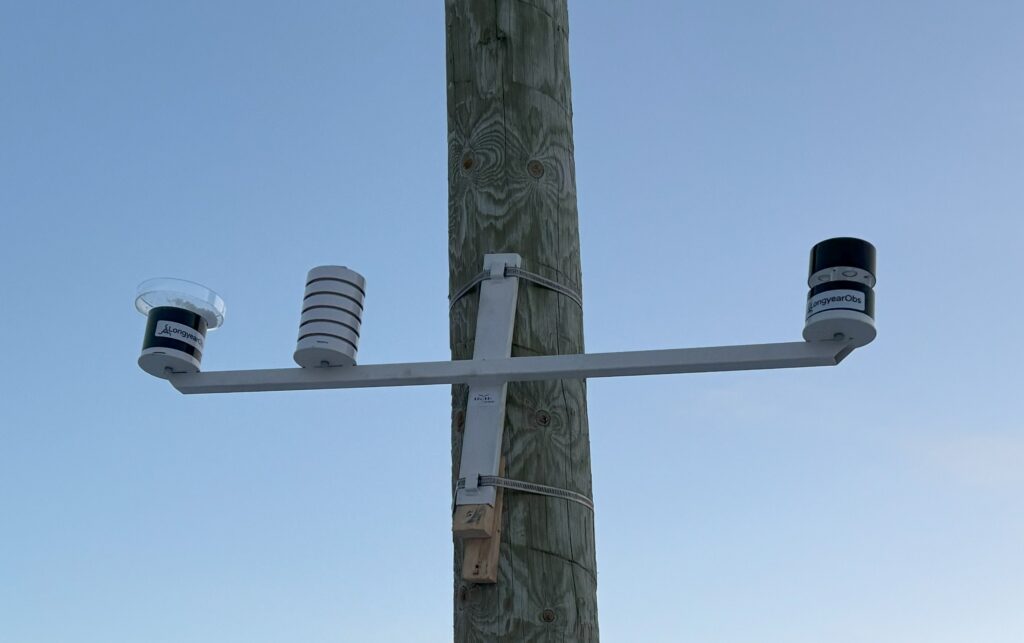Residents of Longyearbyen can contrribute to the LongyearObs project by hosting a private weather station. These stations are Netatmo Smart Home Weather Stations, provided by LongyearObs.
If you are interested, please contact us: info@longyearobs.com

Who can contribute?
You can host a private weather station from LongyearObs if you:
- Plan to live in Longyearbyen for at least two years.
- Have a stable Wi-Fi connection that is not one of the following incompatible networks:
- Incompatible networks:
- Public and company Wi-Fi networks.
- Networks operating only on the 5GHz frequency band.
- Networks using captive portals (requiring login via a web page).
- Some networks that rely on Wi-Fi signal repeaters.
- Incompatible networks:
If your network meets these conditions, you can help improve local weather monitoring by joining the project!
How to set up a private weather station?
Your private weather station consists of four modules. The indoor module must be connected to your home Wi-Fi before setting up the outdoor sensors.
1. Prepare your smartphone or tablet
- Make sure your device is connected to your home Wi-Fi.
- Download the Netatmo Weather app from the Apple App Store or Google Play Store.
- Ensure that Bluetooth is enabled on your phone or tablet.
2. Set up the indoor Module
- Open the Netatmo Weather app and create an account (or log in if you already have one).
- Plug the indoor module into a standard power outlet using the provided charger. Place it in a location with a strong Wi-Fi signal.
- The LED will flash green three times when powered on.
- In the app, go to Settings -> Install new products -> select “Smart Home Weather Station”.
- Tap the top of the indoor module until the LED flashes blue or white, then follow the app instructions.
For detailed instructions, visit the official Netatmo webpage:
🔗 Netatmo Setup Guide
(Here, you will also find steps for installation using a computer.)
3. Set up the outdoor modules
The app will guide you through connecting the three outdoor modules.
Once all modules are connected to your Wi-Fi, the LongyearObs team will assist you with installing the outdoor modules. Most Netatmo stations are mounted on lampposts to ensure that measurements meet scientific standards and can be used for research. By hosting a private weather station, you are contributing to local weather monitoring in Longyearbyen. Thank you for your support!
What does my private weather station measure?
The indoor module of the weather station measures temperature, humidity, CO2 concentration and air pressure. In addition to this module, you will receive three outdoor modules. One that measures temperature and humidity, this looks like the indoor module, only a little smaller. It is installed in a radiation shield, a white plastic structure that prevents sunlight from heating the sensor. Then there is an instrument that measures the amount of rain and one that measures wind speed and direction.
What data do I and others see?
You can see all the parameters your weather station measures in the Netatmo app. So you get the temperature, humidity, CO2 concentration, air pressure from inside your house and temperature, humidity, amount of rain and wind from right outside your door. Isn’t that cool?
Others will only have access to the outside parameters, so don’t worry about anyone knowing how warm your living room is.
How does a Netatmo weather station work?
Precipitation
A tipping bucket rain gauge is used to measure precipitation.
Rain is collected over the funnel area of the rain gauge. The water is collected in a bucket that tilts as it flows, and the number of times the bucket tilts is measured using a magnet placed on the bucket. The weight of the water together with the area of collection is then calculated to the amount of rain in mm/h. Precipitation of 1 mm is equal to one liter of water per square meter. The Netatmo app shows the level of rainfall in mm/h during the last hour and the amount of rain accumulated during the day (from midnight to midnight).
Snow is not directly measured by Netatmo’s Rain Garage, as it only accumulates in the funnel and does not fill the buckets. However, if the snow in the garage melts, it can cause an artificial signal.
Wind
The device that measures the wind is called an anemometer. On the anemometer is a north arrow that must point to the north pole to get the correct wind direction. Wind speed and direction are measured using 4 ultrasonic transducers. The anemometer measures the time between when an acoustic signal is sent and when it is received in two perpendicular directions.
The speeds on the N-S and W-E axes are then combined using trigonometric functions to obtain the true speed and direction. In the Netatmo app you will see the average speed and direction over the last 5 minutes. In order to get an accurate wind measurement, it is important that the wind at the sensor position is not affected by shielding effects of e.g. buildings or other objects.
